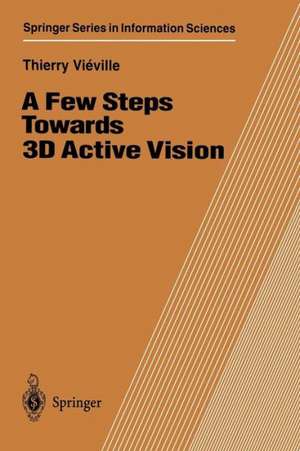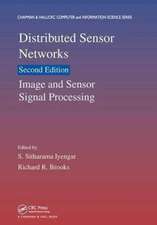A Few Steps Towards 3D Active Vision: Springer Series in Information Sciences, cartea 33
Autor Thierry Vievilleen Limba Engleză Paperback – 13 noi 2013
Din seria Springer Series in Information Sciences
- 20%
 Preț: 337.66 lei
Preț: 337.66 lei - 18%
 Preț: 955.08 lei
Preț: 955.08 lei - 15%
 Preț: 646.62 lei
Preț: 646.62 lei - 20%
 Preț: 337.52 lei
Preț: 337.52 lei -
 Preț: 385.62 lei
Preț: 385.62 lei -
 Preț: 381.98 lei
Preț: 381.98 lei -
 Preț: 391.61 lei
Preț: 391.61 lei - 20%
 Preț: 324.64 lei
Preț: 324.64 lei -
 Preț: 380.84 lei
Preț: 380.84 lei - 18%
 Preț: 777.69 lei
Preț: 777.69 lei -
 Preț: 387.96 lei
Preț: 387.96 lei -
 Preț: 396.62 lei
Preț: 396.62 lei - 20%
 Preț: 330.75 lei
Preț: 330.75 lei -
 Preț: 382.57 lei
Preț: 382.57 lei - 15%
 Preț: 642.18 lei
Preț: 642.18 lei - 15%
 Preț: 640.06 lei
Preț: 640.06 lei -
 Preț: 387.58 lei
Preț: 387.58 lei - 20%
 Preț: 333.40 lei
Preț: 333.40 lei -
 Preț: 386.99 lei
Preț: 386.99 lei - 20%
 Preț: 653.71 lei
Preț: 653.71 lei - 15%
 Preț: 661.02 lei
Preț: 661.02 lei - 18%
 Preț: 1391.21 lei
Preț: 1391.21 lei - 15%
 Preț: 638.43 lei
Preț: 638.43 lei - 15%
 Preț: 642.68 lei
Preț: 642.68 lei - 20%
 Preț: 649.60 lei
Preț: 649.60 lei - 18%
 Preț: 950.21 lei
Preț: 950.21 lei -
 Preț: 393.35 lei
Preț: 393.35 lei - 20%
 Preț: 652.41 lei
Preț: 652.41 lei - 20%
 Preț: 645.65 lei
Preț: 645.65 lei -
 Preț: 390.25 lei
Preț: 390.25 lei -
 Preț: 387.96 lei
Preț: 387.96 lei - 15%
 Preț: 580.97 lei
Preț: 580.97 lei
Preț: 386.00 lei
Nou
Puncte Express: 579
Preț estimativ în valută:
73.86€ • 78.98$ • 61.58£
73.86€ • 78.98$ • 61.58£
Carte tipărită la comandă
Livrare economică 17 aprilie-01 mai
Preluare comenzi: 021 569.72.76
Specificații
ISBN-13: 9783642645808
ISBN-10: 3642645801
Pagini: 260
Ilustrații: XII, 243 p. 39 illus.
Dimensiuni: 155 x 235 x 14 mm
Greutate: 0.37 kg
Ediția:Softcover reprint of the original 1st ed. 1997
Editura: Springer Berlin, Heidelberg
Colecția Springer
Seria Springer Series in Information Sciences
Locul publicării:Berlin, Heidelberg, Germany
ISBN-10: 3642645801
Pagini: 260
Ilustrații: XII, 243 p. 39 illus.
Dimensiuni: 155 x 235 x 14 mm
Greutate: 0.37 kg
Ediția:Softcover reprint of the original 1st ed. 1997
Editura: Springer Berlin, Heidelberg
Colecția Springer
Seria Springer Series in Information Sciences
Locul publicării:Berlin, Heidelberg, Germany
Public țintă
Professional/practitionerCuprins
1. From 2D to 3D Active Vision.- 1.1 The Concept of Active Vision.- 1.2 A Short Review of Existing Active Visual Systems.- 1.3 Architecture of an Active Visual System.- 1.4 2D Versus 3D Vision in an Active Visual System.- 1.5 Gaze Control in 3D Active Visual Systems.- 2. 3D Active Vision on a Robotic Head.- 2.1 A One-to-One 3D Gaze Controller.- 2.2 Active Observation of a 3D Visual Target.- 2.2.3 Statistical Filtering of the Linearized Model.- 2.3 Detection of Visual Targets for 3D Visual Perception.- 2.4 Computing the 3D Parameters of a Target.- 2.5 Experimental Results.- 3. Auto-Calibration of a Robotic Head.- 3.1 Introduction.- 3.2 Reviewing the Problem of Visual Sensor Calibration.- 3.3 Equations for the Tracking of a Stationary Point.- 3.4 Recovering the Parameters of the Trajectory.- 3.5 Computing Calibration Parameters.- 3.6 Experimental Results.- 3.7 Conclusion.- 3.8 Comparison with the Case of Known Translations.- 3.9 Application to the Case of a Binocular Head.- 3.10 Instantaneous Equations for Calibration.- 4. Inertial Cues in an Active Visual System.- 4.1 Introduction.- 4.2 The Use of Inertial Forces in a Robotic System.- 4.3 Auto-Calibration of Inertial Sensors.- 4.4 Separation Between Gravity and Linear Acceleration.- 4.5 Integration of Angular Position.- 4.6 Computing Self-Motion with a Vertical Estimate.- 4.7 Conclusion.- 5. Retinal Motion as a Cue for Active Vision.- 5.1 Definition and Notation.- 5.2 Using Collineations to Analyse the Retinal Motion.- 5.3 Estimation of Retinal Motion from Correspondences.- 5.4 Implementation and Experimental Results.- 5.5 Conclusion.- 6. Uncalibrated Motion of Points and Lines.- 6.1 Introduction.- 6.2 Representations of the Retinal Motion for Points.- 6.3 Representations of the Retinal Motion for Points and Lines.- 6.4Implementation and Experimental Results.- 6.5 Conclusion.- 6.6 Application to the Planar Case.- 7. Conclusion.- References.
Textul de pe ultima copertă
A Few Steps Towards 3D Active Vision describes several modules that can be used to perform 3D vision. A specific problem in the field of active vision is analyzed, namely how suitable is it to explicitly use 3D visual cues in a reactive visual task? The author has collected a set of studies on this subject and has used these experimental and theoretical developments to propose a synthetic view on the problem, completed by some specific experiments. With this book scientists and graduate students will have a complete set of methods, algorithms, and experiments to introduce 3D visual cues in active visual perception mechanisms such as autocalibration of visual sensors on robotic heads and mobile robots. Analogies with biological visual systems provide an easy introduction to this subject.
Caracteristici
Analyses a specific problem in the field of active vision Provides scientists and graduate students with a complete set of methods, algorithms, and experimentations Analogies to biological visual systems allow undergraduates an easy introduction to this subject























